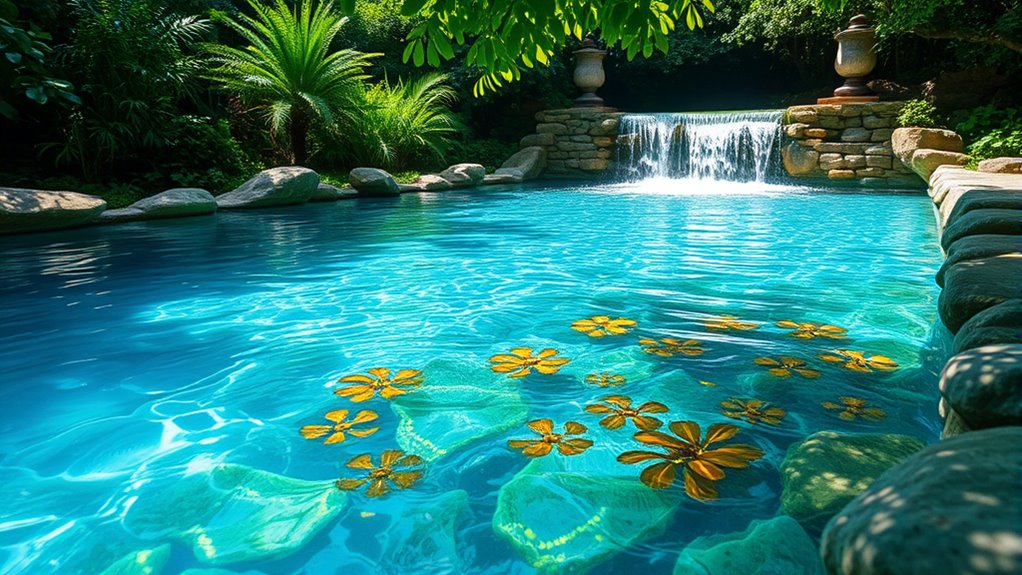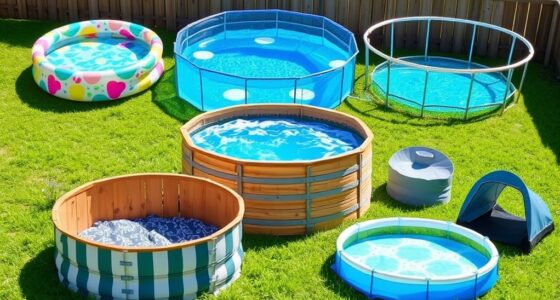Natural swimming pools offer an eco-friendly alternative by using plants, beneficial bacteria, and biological media to keep water clean without chemicals. You’ll enjoy clear, safe water while supporting wildlife and reducing chemical use. These pools are energy-efficient, low-maintenance, and blend seamlessly into natural landscapes. While they promote sustainability, they may require more initial planning and specialized upkeep. If you want to understand how these pools work and their benefits, there’s plenty more valuable information ahead.
Key Takeaways
- Natural swimming pools use biological filtration with plants and beneficial bacteria instead of chemicals to maintain water clarity.
- They offer eco-friendly, chemical-free swimming experiences that support local wildlife and promote biodiversity.
- Pros include lower energy costs, reduced chemical use, and a sustainable ecosystem, while cons involve higher initial setup and maintenance.
- How they work involves a regeneration zone where natural processes filter and purify water, creating a self-sustaining ecosystem.
- Proper design and ongoing maintenance are essential for long-term water quality and ecological balance in natural pools.

Have you ever wondered if you can enjoy a swimming pool that’s both beautiful and eco-friendly? Natural swimming pools make that possible by blending aesthetics with sustainability. These pools rely on eco friendly filtration systems that use natural processes instead of chemicals, making them healthier for you and the environment. Instead of traditional chlorinated water, they harness biological balance to keep the water clean and clear. This means that plants, beneficial bacteria, and natural filtration layers work together to break down contaminants, creating a self-sustaining ecosystem that requires minimal chemical intervention.
Natural swimming pools use eco-friendly, chemical-free filtration systems powered by plants and beneficial bacteria.
When you opt for a natural swimming pool, you’re choosing a design that emphasizes ecological harmony. The filtration system typically involves a designated regeneration zone filled with aquatic plants and biological media. These plants absorb nutrients and help maintain water clarity, while the beneficial bacteria naturally digest organic matter. This biological balance is vital because it ensures the water remains safe and inviting without resorting to harsh chemicals. As a result, you get to swim in water that’s not only visually stunning but also healthier for your skin, eyes, and respiratory system.
Maintaining an eco friendly filtration system in a natural pool is straightforward once it’s properly established. You won’t need to deal with chlorine or algaecides, which can be harsh and damaging over time. Instead, you simply monitor the health of the plants and bacteria, making minor adjustments as needed. The biological balance naturally keeps algae at bay, ensuring your pool stays clear and inviting. Plus, because these systems use renewable biological processes, they consume less energy compared to conventional filtration methods, helping you reduce your carbon footprint.
You’ll also notice that natural swimming pools blend seamlessly into their surroundings, often resembling a pond or lagoon. Their design encourages biodiversity, attracting local wildlife and promoting a sustainable environment. This aesthetic appeal is complemented by the ecological benefits — you’re not just creating a pool, but a thriving ecosystem that supports local flora and fauna. With proper planning and maintenance, your natural pool can stay pristine for years, providing a refreshing and eco-conscious escape right in your backyard.
In the end, choosing a natural swimming pool means embracing a lifestyle that values sustainability, health, and beauty. The combination of eco friendly filtration and biological balance creates a serene, chemical-free oasis that’s as good for the planet as it is for your enjoyment.
Frequently Asked Questions
What Maintenance Is Involved in Natural Swimming Pools?
You’ll need to regularly check and maintain your natural swimming pool’s biological filtration system to keep the water clean and healthy. This involves cleaning the filter and removing debris from the plant zones. Unlike traditional pools, you won’t need chemical treatments often, but occasional natural treatments like adding beneficial bacteria can help. Consistent upkeep guarantees clear, chemical-free water, making your swimming experience enjoyable and eco-friendly.
Are Natural Pools Suitable for All Climates?
You wonder if natural pools suit all climates. Climate adaptability varies because regional feasibility depends on your area’s temperature and sunlight. In warmer regions, natural pools thrive year-round with minimal heating. Cooler or cloudy climates may require additional measures like covers or heaters. So, assess your local climate carefully to determine if a natural pool fits your environment, ensuring it’s a practical and enjoyable addition to your space.
How Long Does It Take to Build a Natural Pool?
Imagine the sun setting as you watch your dream pool take shape. Building a natural pool typically takes 3 to 6 months, depending on your construction timeline and design phases. You’ll start with excavation and design planning, then move through installation of natural filtration systems and planting zones. Patience is key, but soon, you’ll be relaxing in a beautiful, eco-friendly oasis that’s uniquely yours.
What Is the Cost Difference Compared to Traditional Pools?
When comparing costs, natural swimming pools often have a higher upfront price due to specialized design and materials. However, over time, they tend to be more affordable because they require less maintenance and chemical expenses. Your affordability analysis should weigh these initial costs against ongoing savings. Ultimately, natural pools might be a cost-effective choice long-term, especially if you prioritize eco-friendliness and lower maintenance, making them a smart investment.
Can Natural Pools Be Integrated With Existing Landscapes?
You can definitely integrate natural pools with your existing landscape by focusing on landscaping integration and eco-friendly design. You’ll want to contemplate how the pool’s shape and surrounding plants blend seamlessly into your yard. Incorporate native plants, rocks, and natural materials to create a harmonious look. This approach not only enhances beauty but also supports sustainability, making your outdoor space more eco-friendly and visually appealing.
Conclusion
Natural swimming pools offer a harmonious blend of beauty and eco-friendliness, turning your backyard into a mini oasis. While they require some upkeep, their chemical-free waters and lush landscapes make them worth the effort. Think of them as a living, breathing sanctuary that refreshes your body and soul. With a little planning and care, you’ll enjoy a sustainable haven where nature and relaxation swim side by side, creating a peaceful retreat just for you.










